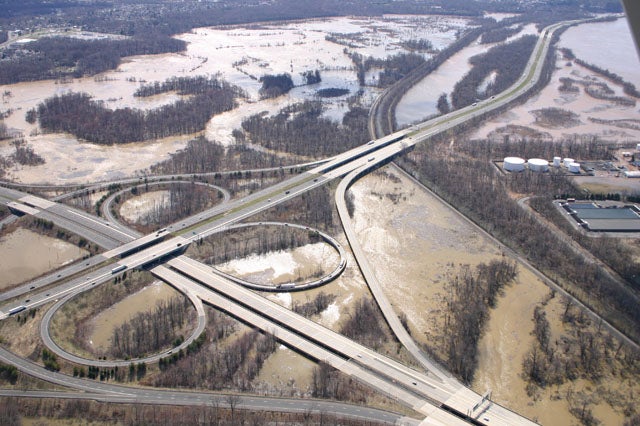How to fix flooding on the Delaware

By Kellie Patrick Gates
For PlanPhilly
Yardley Mayor Matthew Sinberg clicked through pictures showing his small Bucks County borough inundated with river water – as it has been three times in the past few years.
His audience: Attendees and fellow presenters at Tuesday night’s “Solutions to Flooding of the Delaware River” symposium, sponsored by the Environmental Leadership Program, a Washington, D.C., organization that aims to train environmental leaders.
In one photo Sinberg showed the small group gathered at Trenton’s War Memorial, the Delaware’s waters nearly reached a home’s second story. Another showed what looked like a large stream, except for the red shape of a stop sign sticking up above the water that proved this was a submerged street. And there were borough employees on a boat, going to houses to retrieve the medicine or pets people left behind when they evacuated.
“Two days later, the water goes back,” he said. “People go in, and they throw everything they have out.”
The borough with a $1.1 million budget spent hundreds of thousands on cleanup and repair each time – including the rebuilding of a collapsed sewer system – most of which was reimbursed by the federal government. The federal and state governments and insurance companies also helped residents rebuild – but some just finished doing so when the next flood hit.
The mayor’s show-and-tell was designed to give his audience some dramatic evidence of what happens when the river floods, and after the waters recede.
Other presenters talked about how to avoid the ugly scenarios in Sinberg’s pictures. None were cheap or easy to implement, and many would likely prove controversial.
Jeffrey Featherstone, director of the Center for Sustainable Communities at Temple University’s Ambler campus, said that an early step has to be updating the flood zone maps so that everyone understands where the dangers actually lie.
The current maps were mostly made in the late 1970s and early ‘80s, he said. Better technology now allows for more detail and accuracy, he said. Also, development that has occurred since then has created more impervious surfaces, sending more runoff water into streams and rivers and causing them to flood more often.
When his Center remapped the Pennypack watershed, they found some areas in which the watershed was actually much larger than anticipated, and other areas where it had shifted so that some homes once thought to be in the flood plain are not, and others that were thought outside the danger area are within it. Sometimes, the streams are not even in the right locations, he said.
Shandor Szalay, senior project manager with AKRF, Inc., an environmental engineering, planning and consulting firm with offices around the Northeast, and Benjamin Spinelli, executive director of the New Jersey Office of Smart Growth – which used to be called the state planning office – presented similar ideas on storm water management and flood prevention.
One key theme: It floods in the flood plain, so don’t build homes there.
“The paradox of flooding is it is incredibly destructive, but it is also rejuvenating” ecologically speaking, Szalay said. “If we apply that paradox to the Delaware River, we need to find ways to allow flood plains to be flood plains, and allow communities to exist in places where they do not deal with this.”
Spinelli put it like this: “You can put ice on your thumb after you hit it with a hammer, but its better not to hit yourself in the first place. We have to look at where do we build and how do we build.”
That means regulating new construction – perhaps by adding construction-free buffer zones alongside flood plains – and purchasing property that repeatedly floods, they said.
Buffer zones can help tremendously, they said, because forested land retains much more water than developed land does.
But what would it mean for places that already exist in a flood zone – places like Yardley? Spinelli said it’s a tough question.
Sinberg, Yardley’s mayor, said that FEMA has purchased some homes that repeatedly flooded. But now the borough has both lost tax revenue and is stuck with vacant land it has to maintain.
Some borough residents – including him – have raised their houses up above the flood levels. But that’s expensive, he said, and much of the money has to come from homeowners.
Sinberg brought his friend and anti-flooding activist Edward “Skip” Garlits to the symposium to do part of the presenting.
Sinberg owns rental properties in the borough, and also owns a printing business and a daycare center. He has degrees in business and building technology, and he was a contributor to the Delaware River Basin Task Force on Interstate Flood Mitigation, which recently turned a report over two the governors of both New Jersey and Pennsylvania.
Unlike the other presenters, Sinberg supports a structural solution to the flooding problems – he thinks a dam should be built at Wallpack Bend, in the Delaware River Gap National Recreation Area. The gates would be kept open “99 percent of the time” he said, but closed when there is danger of flooding.
The extra water would flood some of the park land, he said, but that would be very much preferable to flooding homes and businesses.
Sinberg’s plan – which he talks about at flood-related meetings whenever possible – also calls for lake that could be used for recreation or to hold extra water, and allows for generation of electricity.
Szalay said that dams and other structural solutions create environmental problems, cost a lot of money to maintain, and can fail with horrific results.
“(Hurricane) Katrina is a classic example of what can happen with a structural approach,” he said. “It’s extremely expensive to build and maintain over time.”.
Spinelli said costs and benefits would need to be weighed, but he questioned the wisdom of inundating environmentally sensitive land with water – even if it was only when a flood was expected.
Sinberg’s solution did not make the report on the governors’ desks, but there is a paragraph within it that says structural solutions should be considered.
You can reach Kellie Patrick Gates at kelliespatrick@gmail.com
WHYY is your source for fact-based, in-depth journalism and information. As a nonprofit organization, we rely on financial support from readers like you. Please give today.






